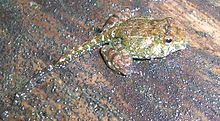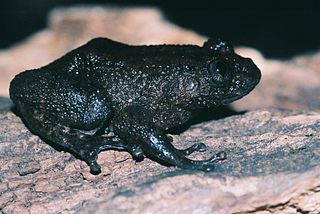
Nyctibatrachus is a genus of frogs endemic to the Western Ghats of southwestern India. Their common name is night frogs. Their scientific name also means "night frog", in reference to their habits and dark color. They are the only extant members of the monotypic subfamily Nyctibatrachinae. Currently, 35 species belong to Nyctibatrachus.

Conraua, known as slippery frogs or giant frogs is a genus of large frogs from sub-Saharan Africa. Conraua is the only genus in the family Conrauidae. Alternatively, it may be placed in the family Petropedetidae.
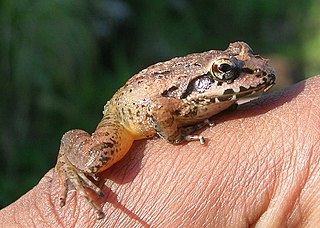
Indirana semipalmata is a species of frog endemic to the Western Ghats region of southern India. They are small frogs, reaching lengths of about 36 mm (1.4 in) from snout to vent. The species breeds during the monsoons, laying their eggs on moist rocks and tree bark. Their tadpoles are terrestrial – hatching, feeding, and undergoing metamorphosis without ever entering any standing bodies of water.
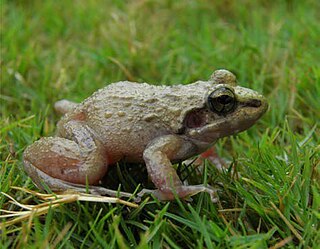
Indirana leithii is a species of frog in the family Ranixalidae. It is endemic to the northern Western Ghats of India. As currently defined, its range is restricted to the states of Maharashtra and southern Gujarat; earlier records elsewhere refer to other species.
Indirana tenuilingua is a species of frog that is considered nomen inquirendum. It is only known from the type series, now lost, from its type locality, Kemphole, in the Western Ghats of India. It is sometimes known as Rao's Indian frog or slender-tongued frog.

Phytotriades is a genus of tree frogs in the family Hylidae. As currently delimited, the genus is monotypic and contains Phytotriades auratus, commonly known as the golden tree frog, bromeliad-dwelling treefrog, El Tucuche golden tree frog, or Trinidad heart-tongued frog.

The Petropedetidae are a family of frogs containing three genera and 12 species. They are found in sub-Saharan tropical Africa and are sometimes known under common name African torrent frogs.

Nyctibatrachidae is a small family of frogs found in the Western Ghats of India and in Sri Lanka. Their common name is robust frogs. Recognition of Nyctibatrachidae as a family is fairly recent. These frogs were previously placed in the broadly defined family Ranidae, which was more recently divided into three subfamilies: Lankanectinae, Nyctibatrachinae, and Astrobatrachinae.

Raorchestes is a genus of frogs in the subfamily Rhacophorinae that are found in mountainous regions of South Asia, Southeast Asia, and southern China. A recent study places Raorchestes as a sister taxon of Pseudophilautus. Before the description of the genus in 2010, species now in Raorchestes had been assigned to genera Ixalus, Philautus, and Pseudophilautus.

Ranixalidae is a family of frogs commonly known as the leaping frogs or Indian frogs. They are endemic to central and southern India, specifically in the Western Ghat mountain range. This mountain range encompasses the Indian states of Gujarat, Maharashtra, Goa, Karnataka, Kerala, and Tamil Nadu. Ranixalidae can be found in Maharashtra, Goa, Karnataka, and Kerala. There is a large concentration of them in Goa and Maharashtra, however there are still considerable amounts of species within the southern Indian states of Karnataka and Kerala, where there are other frogs within the Indirana genus.

Indirana chiravasi is a species of frog endemic to the Western Ghats of India. It is only known from its type locality, the laterite plateaus by the hill-station of Amboli, Maharashtra. It was described in 2014 by a team of three scientists from IISER, Pune and MES Abasaheb Garware College.
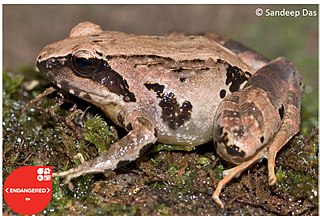
Walkerana is a genus of frogs in the family Ranixalidae. The genus is endemic to the Western Ghats in the states of Kerala and Tamil Nadu, India. It was erected in 2016 to host three species of Indirana that represented a genetically and morphologically distinct clade within the then broadly defined Indirana. Until Walkerana muduga was described in 2020, the genus was only known from the southernmost part of the Western Ghats south of the Palghat Gap.
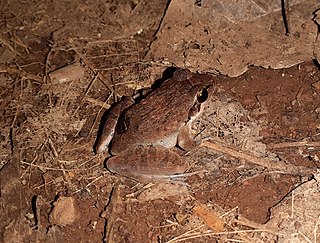
Indirana tysoni, also known by its common name Tyson's leaping frog, is a species from the genus Indirana. The species was originally described in 2016 by Neelesh Dahanukar, Nikhil Modak, Keerthi Krutha, P. O. Nameer, Anand D. Padhye, and Sanjay Molur.
Indirana salelkari, the Netravali leaping frog, is a species of frog in the family Ranixalidae. It is endemic to India's Western Ghat mountains.
Indirana bhadrai, the Bhadra leaping frog, is a species of frog in the family Ranixalidae. It is endemic to India's Western Ghat mountains, north of the Palged Gap.
Indirana paramakri, the rocky terrain leaping frog or Suganthagiri leaping frog, is a frog in the family Ranixalidae. It is endemic to Kerala, India in the Western Ghat mountains.
Indirana yadera, the Yadera leaping frog, is a frog in the family Ranixalidae. It is endemic to India's Western Ghat mountains.
Indirana sarojamma, or Sarojamma's leaping frog, is a species of frog in the family Ranixalidae. It is endemic to in Kerala, India in the Western Ghat mountains, south of the Palghat Gap.
Indirana duboisi, the Karnataka leaping frog or Dubois's leaping frog, is a frog. It is endemic to India in the Western Ghat mountains.

